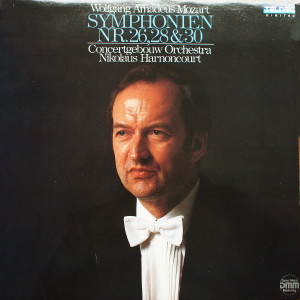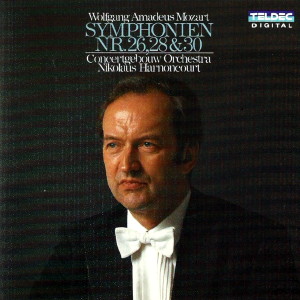 |
1 LP -
6.44090 AZ - (p) 1988
|
 |
| 1 CD -
8.44090 ZK - (p) 1988 |
|
| Wolfgang
Amadeus Mozart (1756-1791) |
|
|
|
|
|
|
|
Symphonie (Ouverture) Nr. 26
Es-dur, KV 184 (161a)
|
|
8' 51" |
|
| - Molto presto |
2' 43" |
|
A1 |
- Andante
|
3' 33" |
|
A2 |
| - Allegro |
2' 35" |
|
A3 |
Symphonie
Nr. 28 C-dur, KV 200 (189k)
|
|
22' 16" |
|
- Allegro spiritoso
|
7' 11" |
|
A4 |
| - Andante |
7' 15" |
|
A5 |
- Menuetto: Allegretto -
Trio
|
2' 57" |
|
B1 |
| - Presto |
4' 55" |
|
B2 |
| Symphonie
Nr. 30 D-dur, KV 202 (186b) |
|
17' 18" |
|
- Molto allegro
|
3' 19" |
|
B3 |
| - Andantino con moto |
6' 32" |
|
B4 |
| - Menuetto - Trio |
3' 28" |
|
B5 |
| - Presto |
3' 59" |
|
B6 |
|
|
|
|
| CONCERTGEBOUW ORCHESTRA,
AMSTERDAM |
|
| Nikolaus
Harnoncourt, Dirigent |
|
|
Luogo
e data di registrazione
|
Concertgebouw,
Amsterdam (Olanda) - gennaio / febbraio
1988
|
|
Registrazione
live / studio
|
| studio |
Producer
/ Engineer
|
Wolfgang
Mohr / Michael Bramman
|
Prima Edizione CD
|
| Teldec
- 8.44090 ZK - (1 cd) - 53' 42" - (p)
1988 - DDD |
Prima
Edizione LP
|
Teldec - 6.44090
AZ - (1 lp) - 53'
42"
- (p) 1988
- Digital
|
|
|
Notes
|
We really don’t know
very much about the life of the Mozart
family in 1773 and 1774, the years in
which W. A. Mozart composed the
symphonies nos. 25, 28 and 30. In
mid-March 1773, Mozart senior and junior
had returned to Salzburg from Milan
after the great success of “Lucio
Silla" there; it was to remain
Wolfgang Amadeus’ last visit to Italy.
In mid-July they
travelled from Salzburg to Vienna:
Mozart’s father hoped to find a
position there for his son, as he had
tried to do in Italy.
But in the Austrian capital, too, his
endeavours were in
vain, and they returned to Salzbourg
at the end of September. This time
they stayed in Salzburg for over a
year, before leaving for Munich in
December 1774 to direct rehearsals of
the opera "La
finta giardiniera".
This chronicle of Mozart’s travels
would be of no further interest in the
discussion of the symphonies, were it
not for the fact that the influence of
diverse local styles can be traced in
the works themselves. The Symphony no.
26 in E flat major is dated 30th March
1773, which means it was completed
within two weeks of the Mozart’s
return from Italy -
and the music altogether breathes the
spirit of that land. Unlike its
predecessors with four movements in
the South German-Austrian tradition,
no. 26 has three movements after the Italian
model, and it has repeatedly been
suggested that is was originally
conceived as the overture to
incidental music for a play. This idea
is lent substance by the “speaking”,
almost recitative-like motifs, which
are imbued with pathos in the slow
middle movement in particular. The
stylistic proximity to “Lucio Silla”
is especially evident in this
movement, which extends the light,
festive overture atmosphere usual in
the opening movement by those
forbidding overtones that had already
taken “Lucio Silla“ well beyond the
confines of quotidian Italian opera.
Symphonies nos. 30 in D major
(dated 5th May 1774) and 28 in C major
(composed in November 1774) come from
the same period as the far better
known, and more important symphonies
nos. 29 in A major and 27 in G minor:
in contrast to no. 26, they belong to
the South German tradition. Both works
have four movements with a minuet
between the slow and the last
movements, and the thematic treatment
is reminiscent of the Haydn brothers.
Mozart had already studied Michael
Haydn’s symphonies prior to his last
trip to Italy. He had met Joseph Haydn
in Vienna in 1773, and the deep
impression his music made on the
17-year-old Mozart is reflected not
only in the symphonies, but with great
clarity in the string quartets K.
168-173 as well. The symphonies nos.
28 and 30 both belong to the genre of
light music for festive occasions such
as Archbishop Hieronymus of Salzburg
loved. Beneath the music's unassuming
exterior, however, the challenge that
Haydn’s ideas on thematic and motif
work presented to Mozart is in
evidence. In both
symphonies, Mozart provides motif
links between the outer movements: in
the C major work he reworks a trill
figure from the first subject of the
first movement to form the central
motif of the last movement; and in the
D major symphonie he even repeats the
opening motif of the first movement in
the main subject of the last movement
- here, though, he changes the stress
in the beat, making an upbeat theme
out of a dowhheat one. In
precisely these two
symphonies that seemed to have been
dashed off in a hurry, that great art
is apparent that Leopold Mozart later
recommended to his son in these words:
“Small things are
great when they are written
naturally, with fluency
and lightness, and set with care.”
Silke
Leopold
Translation: Clive Williams
|
|
Nikolaus
Harnoncourt (1929-2016)
|

|

|
|